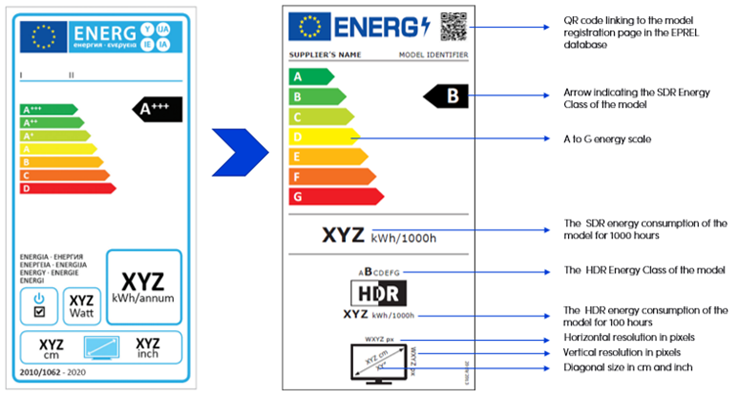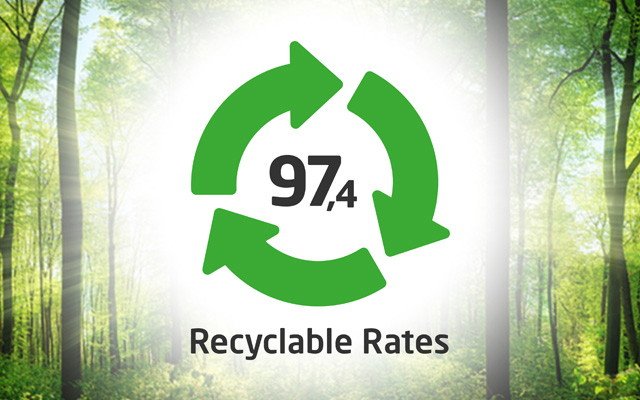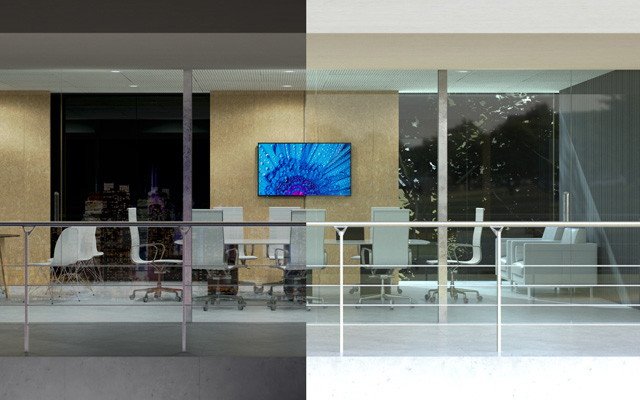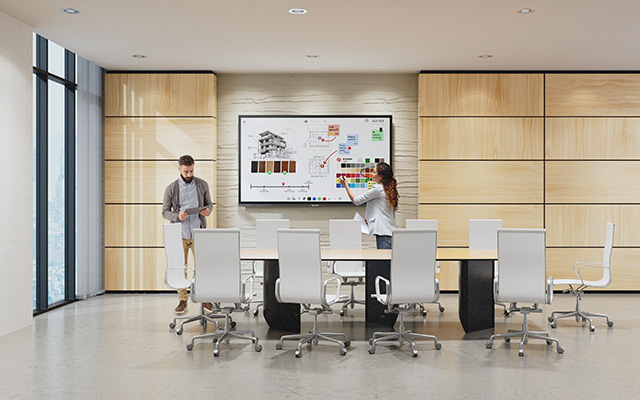The EU Energy Label is driving innovation in sustainable technology
The EU Energy Label gives information about the energy efficiency of a product. We see it on consumer electronic devices such as fridges and dishwashers, but it also applies to digital displays.
The label rates products from dark green (most efficient) to red (least efficient), and displays the total energy consumption alongside other information relevant to the product, such as screen size in the case of digital displays.
All this information is useful when comparing products, to help make an informed purchasing decision, although care must be taken to ensure like for like comparison. It is important to note that interactive displays are excluded from the EU labelling regulation, making it more problematic to compare interactive against non-interactive displays.
Sharp/NEC’s Product Manager for Interactive Solutions, Ralph Kolen, explains more about the Energy Labelling system and what this means for interactive displays.

Ralph Kolen, product manager for interactive solutions at Sharp/NEC
What is the Energy Label?
The energy labelling system was first introduced in 1994. Implemented to help consumers choose more energy efficient products, it has helped to drive innovation into more energy efficient technologies.
Modern technology is highly energy efficient compared to that introduced 30 years ago. For this reason, there have been several revisions to the energy labelling system, alongside changes to the product groups that must comply. In March 2021, a new rating system came into effect.
The Energy Label shows the power consumption and energy efficiency classification of the product. As technology evolved, the most efficient class A became overpopulated, leading to the addition of A +, A ++, and A +++ classifications to differentiate them. To avoid confusion, in 2021 the classifications were realigned to a much simpler A to G scale. Previously high-ranking products may now appear in a lower classification within the new ranking system which will in turn drive even greater efforts by manufacturers to enhance energy efficiency and therefore improve their classification.
According to the European Commission website: 'the EU legislation for energy labels and ecodesign has been estimated to bring energy savings equivalent to approx 230 million tonnes of oil by 2030. For consumers, this means an average saving of up to €285 per year on their household energy bills. Moreover, energy efficiency measures will create €66 billion in extra revenue for European companies.' These figures are significant, indicating the success of the Energy Label and ecodesign initiative.
 Compare the old version of the Energy Label on the left with the new version on the right.
Compare the old version of the Energy Label on the left with the new version on the right.
Why is the Energy Label important?
We must all take action towards a sustainable future; choosing more energy efficient products will help us to reduce the consumption of energy and other natural resources. This change is necessary to help meet the EU’s energy and climate targets, supporting industrial competitiveness and innovation by promoting better environmental performance of products.
The revised scale is not simply a downgrading. The energy criteria for each of the new A-G classes are far more rigorous. The ‘downgrade’ does not mean that the product in itself is less energy efficient, but that the metric used for calculating the energy class has been substantially changed.

Ecodesign: Sharp/NEC achieves recyclability rates averaging 97.4% for its Large Format Displays, almost entirely recyclable.
New ecodesign rules also apply to electronic displays which set mandatory minimum standards for their energy efficiency including a maximum allowable energy consumption when in standby mode. An important element of the more stringent ecodesign rules covers reparability and recyclability. Spare parts must be more easily replaceable with repair and maintenance information available for end users and professional repairers as appropriate.
The revised scaling system also takes into account the screen area. The new labels show the efficiency of a product when it displays content in HDR, as it can consume twice as much energy as other settings. In addition, the label shows information on the diagonal size of the display and the resolution, so that consumers can better compare similar displays.
Why might the datasheet show a different energy consumption?
The calculation of the energy consumption shown on the Energy Label has a very specific criteria defined by the EU certification process. The wattage is calculated at a certain level of brightness and with High Dynamic Range (HDR) enabled which boosts the backlight to deepen the contrast.
The power consumption quoted on the datasheet, however, will be the typical wattage at the default setting for shipping. We ship our displays in the most eco-friendly way possible, at a level of brightness suitable for regular environmental conditions. Unless a display is operating in an area of high ambient light, the highest brightness setting is not required in order to present content with eye-pleasing readability. It is our experience that most end users do not adjust the settings upon installation.
Also bear in mind that the Energy Label quotes energy consumption based on 1000 hours compared to the usage quoted on the datasheet which may use a different measured time.

The ideal brightness of a display will be determined by the ambient light conditions.
What about interactive displays?
The latest regulation regarding ecodesign requirements for displays includes televisions, monitors and digital signage displays. Some specific categories are excluded, however, including ‘digital interactive whiteboards’, a description which encompasses our interactive displays. The exclusion of interactive displays is further confirmed by the product registry for energy labelling which does not include any interactive display products released after 2021.

The interactive Sharp LA Series brings advanced professional functionality to Enterprise users
The EU Frame Regulation on energy labelling prohibits the inappropriate use of an Energy Label meaning it would be illegal to use an Energy Label on an excluded product such as interactive displays.
At Sharp/NEC we regard it as our responsibility to keep our business partners informed, mindful that they would enter into a legal violation should they promote a non-eligible Energy Label. Particularly for tenders, this situation can be an issue. If the tender has not been updated, or the tender demands comparison between interactive displays and non-interactive professional or consumer displays, it can become problematic to convince the procurement authority to overlook the demand in the tender.
The Sharp/NEC perspective
Even though interactive displays are no longer part of the energy labelling regulation, this certainly does not mean that Sharp/NEC does not care anymore. On the contrary, sustainable innovation is one of our core values, developing products with increasingly improved energy efficiency.
Furthermore, we are happy to provide all the data that is featured on an Energy Label in a plain text format. The Energy Label is simply a graphic illustration primarily aimed at private consumers, but the facts behind the graphic are the essence.
Beyond developing more energy efficient products, we will continue to prioritise quality and service as the driver for sustainability, whereby we further extend the long lifecycle through reuse and repair programs. By using metal, not plastic, as the major component in our LED and LCD displays, we are safeguarding the robust longevity and safety of our products and ultimately contributing to the circular economy.
Select your country
Welcome to sharpnecdisplays.eu, please select your country or region.
